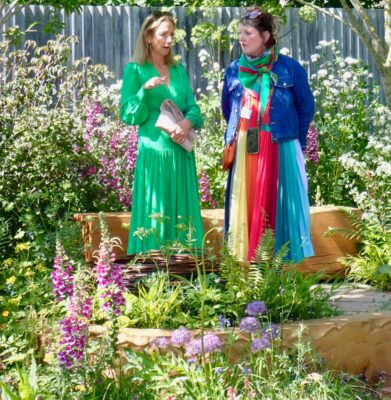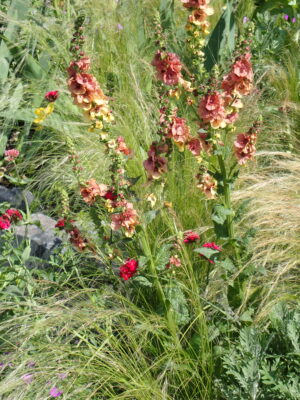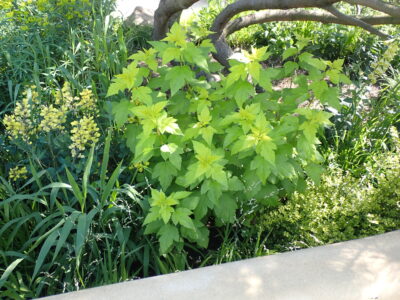I feel as though I’ve been climbing up a very steep mountain, well more of a hill really, and I’ve got to the summit and admired the view and cooed and now I’m plodding down again – with an air of sheer relief. Yes, I’ve been to this year’s Chelsea Flower Show and I’ve seen the good and the glorious. And I don’t just mean the plants. I finally got to speak to my eco-hero, Chris Packham, who was on the Autistic Society’s Garden designed by Sophie Parmenter and Dido Milne. He pointed out the rare sticky catchfly, Viscaria vulgaris, and it was the first time we’d both seen it. He may be Marmite to some, but I love him just as much as the real thing. Chris, I have it for lunch every day.

Enough of the celebrity chit-chat Val. Chelsea’s all about the plants, not the people, and it’s always interesting to see what’s in the gardens. There is a certain sameness, inevitably, because many of the plants are grown by two of our best nurseries – Hortus Loci and Kelways. They provide a range of large plants (very skilfully I might add) to furnish the garden designs. This year, there were lots of leafy woodlanders and subtle shade plants underneath trees. Ula Maria’s Best in Show Muscular Dystrophy Garden contained 50 birches alone. In fact, the only bright and colourful Show Garden was Ann-Marie Powell’s Octavia Hill Garden, aided by the National Trust and Blue Diamond. Two colourful warm terracotta to rust verbascums stood out for me, ‘Clementine’ and ‘Petra’. Ann-Marie’s garden was voted the BBC People’s Choice and the Children’s favourite. Perhaps it’s a coded message to the RHS. More colour please.

The plants change every year though, according to the season, and the ones that get to go into the gardens are the ones that will show flower during Chelsea week. You see, the judges don’t appreciate buds or plants that have gone over, and marks are lost. Aquilegia vulgaris peaked too early this year, although Matthew Child’s Terence Higgin’s Trust Garden displayed the later flowering, wide-winged and long-spurred pallid-yellow Aquilegia chrysantha ‘Yellow Queen’. Trollius ‘Alabaster’ was equally moonlit. Both would prefer good soil and dappled shade.
When it comes to the colour of the medal, it’s all down to numbers in the end. Golds are given to the gardens that achieve a certain score, or above ,for design, concept, build etc. It’s the same with the stands and Hartley Botanic were there – of course – with a glorious stand as always. I just wish Best in Show was awarded for inspiration and pleasure – not just marks- but there aren’t any boxes for them! They’re too hard to quantify.
To the plants though. Saruma henryi was in lots of gardens, sometimes in the ground and sometimes in large containers. It’s a Chinese shade plant of forests, valleys and streambanks, found naturally in Gansu, Guizhou, Hubei, Jiangxi, Shaanxi, and Sichuan. I failed to keep it in the ground in Cold Aston, because Chinese and all Asian woodlanders like drier winters and wetter summers. Cold Aston dishes up the reverse, so it’s rather like pushing water up hill. Growing it in a pot is probably the way to go, although no one could describe this yellow-flowered plants as exciting.
Augustine Henry, a man with an eye for good foliage, saw this plant in China between 1882 and 1889. He sent it off to Kew and the botanist of the time, Daniel Oliver, removed the first letter from asarum (another blokeish woodlander) and shoved it on the end to create the anagram saruma. Oliver would have been good at crosswords, although I suspect cryptic crosswords came after his time. Sometimes, when I’m stuck on the Sunday Toughie in The Telegraph, I wish they hadn’t arrived at all.
Anyway, Saruma henryi died away at Kew Gardens and it’s so comforting to think that their gardeners couldn’t keep it either. It makes me feel so much better. It was rescued by the Japanese plant hunter and explorer, Mikinori Ogisi. He collected seeds from plants at the Wuhan Botanical Institute in 1981. Now where I have heard the name Wuhan before? Let me think. Oh yes, a certain virus. Roy Lancaster was the one of the first to grow it from seeds and he popularised it here.

On the woodland front, there was also a stinging-nettle look alike, that didn’t sting, named Boehmeria platanifolia. The common name is sycamore-leaf false nettle and it’s another Asian woodlander that’s grown for foliage. The serrated soft leaves and white stems are very handsome. The foliage has a pink-hue at first, but settles down to a softly hairy silvery green. It can reach shoulder height in good conditions, which of course I don’t have in my garden. I haven’t grown this because I specialise in British nettles instead, the ones that hurt. They lurk over the low wall, from the field beyond the garden. If I had acres, I might plant this though.
Plants in my garden are on wheels, Anything I don’t like gets dug up and often finds its way into the village fete, which I find even more menacing than the nettles over the wall. Sometimes having visited Chelsea, I’m forced to reassess a plant I’ve previously scorned. One of those, Valeriana officinalis, was in several gardens this year. I have weeded out many of these at Spring Cottage, because this plant self-seeds a little too prolifically even for me. It’s listed as an invasive alien in parts of America, such as northern Wisconsin, having escaped from garden cultivation.

Valeriana officinalis is tall, up to four or five feet, and very slim and columnar. It produces umbel-like heads of moth and butterfly friendly pale-pink flowers and these are heavily scented, almost lily-like in fragrance. The roots are used as a sedative, hence the species name officinalis which translates as official remedy. I have several in flower at the moment, in shadier parts of the garden, and they’ve been joined by the cloud-like heads of Valeriana pyrenaica and a white daisy named Erigeron annuus. To cull, or not to cull, that is the question for they all self-seed enthusiastically.
In past years the Chelsea crowds have been wooed by bearded irises and the dark violet-blue ruffled flowers of ‘Draco’ added dramatic touches in several show gardens. I’m on a hunt for that one, which is so different from the painterly Benton irises found in Sarah Price’s 2023 Show Garden, inspired by Cedric Morris. I fell in love with the caramel, soft-green and pale-blue Iris ‘Benton Olive’ and it’s been wonderful this year. These are becoming more available thanks to their rescuer Sarah Cook’s conservation efforts. Woottens, Crocus and Beth Chatto supply a range of Benton irises by mail order.
This year Siberian irises were more common than sun-loving bearded irises. Pallid-yellows included ‘Butter and Sugar’, which looked very fetching close to the puffs of mauve found on the black-stemmed Thalictrum ‘Black Stocking’. This always performs in May and the vivid-green leaflets overlap and look rather lacy. The award-winning ‘Butter and Sugar’ (McEwan 1976) was ‘the first non-fading yellow and white’ according to Claire Austin’s encyclopaedia of irises. Blue Siberian irises also featured and one of them was the violet-blue ’Persimmon’ sometimes sold as ‘Tycoon’. It’s another on my wants list. As I always say to my daughters, bless them, I’d be a wealthy woman if it wasn’t for plants.











